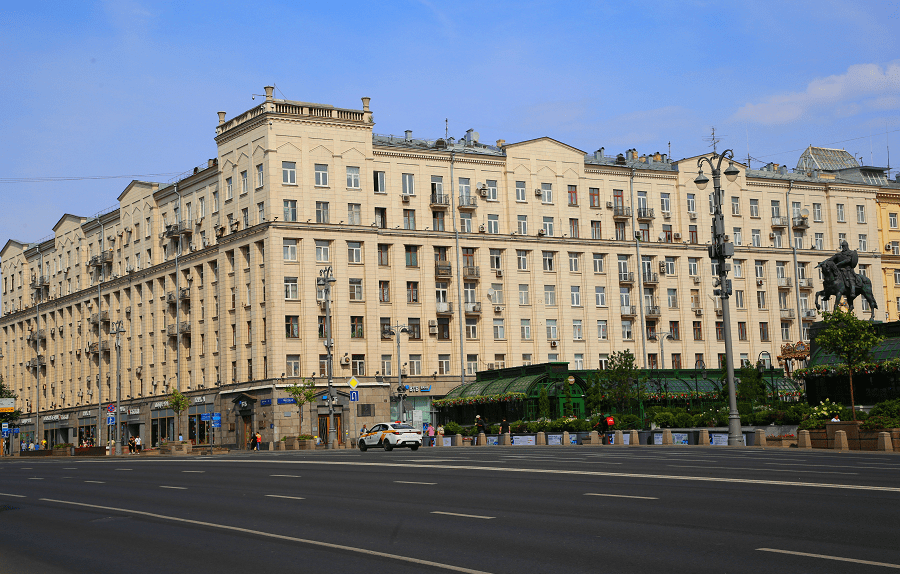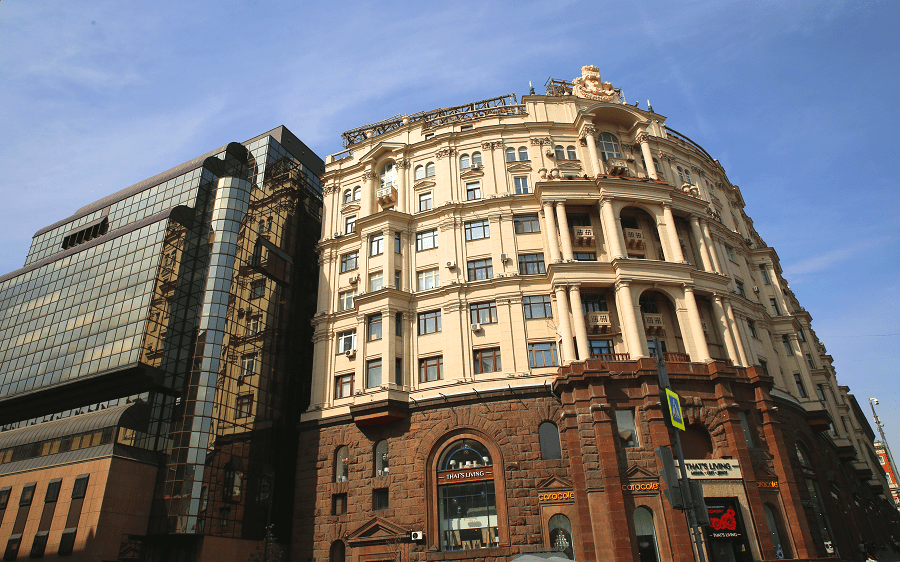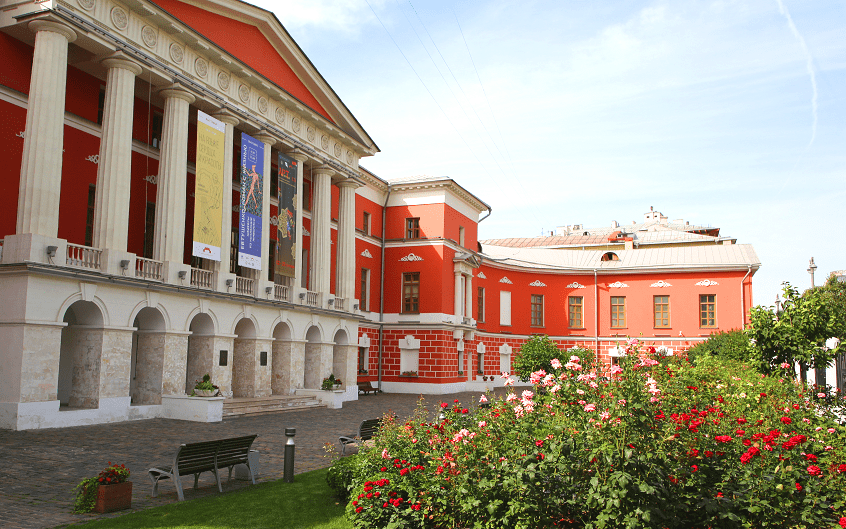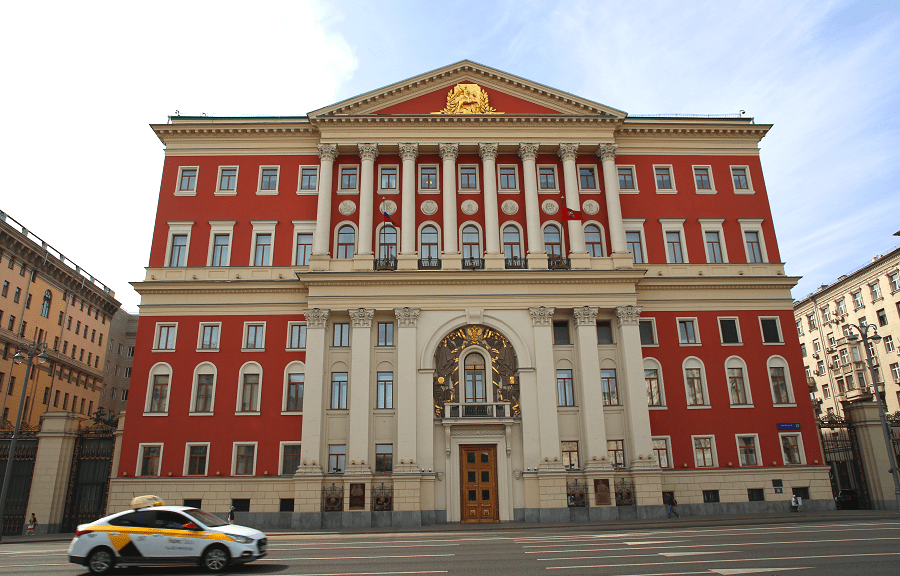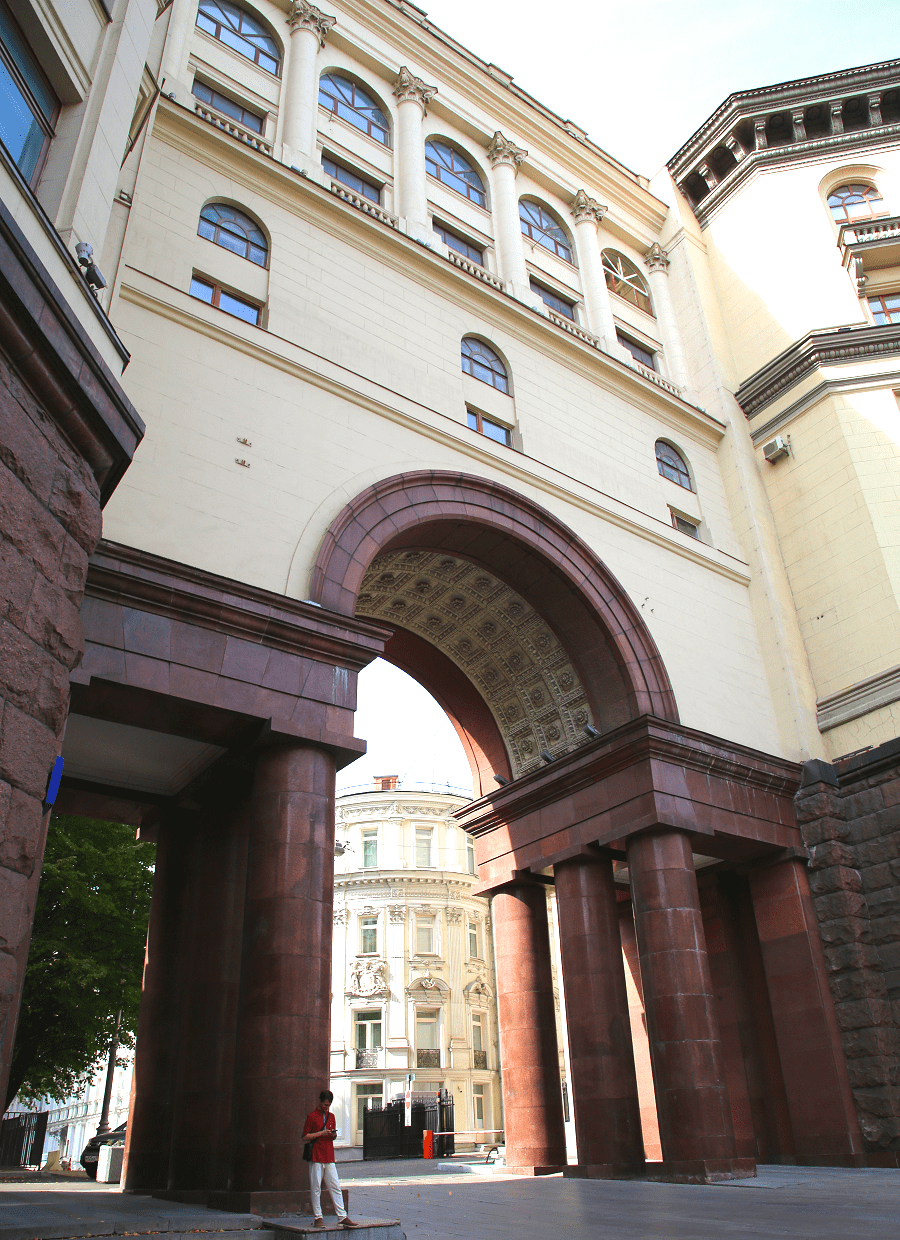Tverskaya Street is the main street of Moscow in the Tverskoy district of the Central Administrative District. It runs from Manezhnaya Square to Triumphalnaya Square.
The street originated as a road to Tver, a section of which within the boundaries of Moscow, from the Iversky Gates of the Kitay-gorod Wall to the gates of the Earthen City, was called Tverskaya Street. Tverskaya Street was significantly expanded and rebuilt in the first half of the 20th century. From 1932 to 1990, 1st Tverskaya-Yamskaya Street was Gorky Street, named after the Soviet writer Maxim Gorky.
Tverskaya Street starts from Manezhnaya Square at the crossroads with Okhotny Ryad and Mokhovaya Street. From the left to Pushkinskaya Square, adjoin Nikitsky, Gazetny, Bryusov, Voznesensky, Leontievsky, Maly and Bolshoi Gnezdnikovsky lanes, to the right – Georgievsky and pedestrian Kamergersky lanes, pedestrian Tverskaya Square with Stoleshnikov lane and Tversky passage located on it, Glinishchevsky and Kozitsky lanes.
On Pushkinskaya Square, the street is crossed by the Boulevard Ring – Tverskoy and Strastnoy Boulevards, as well as Bolshaya Bronnaya Street and Bolshoi Putinkovsky Lane. Further along the odd side, Maly Palashevsky, Mamonovsky and Blagoveshchensky lanes adjoin the street, and on the even side – Nastasinsky, Degtyarny and Staropimenovovsky.
The street ends at Triumfalnaya Square, which overlooks Armory Lane and 1st and 2nd Brest Streets. The Mayakovsky Tunnel was laid under the square, connecting Bolshaya Sadovaya and Sadovaya-Triumfalnaya streets.
Beyond the Garden Ring, Tverskaya Street is continued by 1st Tverskaya-Yamskaya Street (from 1932 to 1990, it was the same as Gorky Street), passing to Tverskaya Zastava, where it passes through Tverskoy overpass into Leningradsky Prospekt near the Belorussky railway station.
History
According to some reports, the road to Tver existed in the 12th century. This road also connected Moscow and Novgorod from the end of the 15th century. Natives of these cities founded their settlement on Tverskaya Street. The development of Tverskaya Street went from the center to the fortress wall of the White City (modern Boulevard Ring).
After the expansion of Moscow at the end of the 16th century, the street was extended to the rampart of the Earthen City (modern Garden Ring). Before this, between the contemporary Pushkinskaya and Triumphalnaya squares near the Tverskaya road, there were fields and a settlement of the Kremlin “collars” (guards at the gates). In the XIV and XV centuries, the street went to the bridge over the Neglinnaya River, opposite the modern Middle Arsenal Tower of the Kremlin. In 1595, a stone Voskresensky Bridge was built across the Neglinnaya River, connecting Tverskaya Street with Red Square.
In the 16th century, courts of the nobility, churches and monasteries began to appear on Tverskaya Street. At the end of the 16th century, Flour, Zhitny and Malt shopping arcades were located on the site of the current Moskva Hotel. In the area of Manezhnaya Square, there were yards of the Streltsy Regiment. In the area of modern Okhotny Ryad and Tverskaya Square, since 1504, lattice gates were locked at night to ensure the safety of the courtyards of the nobility.
In the XVIII-XIX centuries, Tverskaya Street was the city’s main street. The best houses, hotels and shops in Moscow were built here. Among the masterpieces of architectural creativity, one can name the unpreserved palace of Prince M. P. Gagarin with aquarium ceilings (1707-08), the English Club (1780s) and the Eliseevsky shop (1770s, rebuilt in the 1790s and 1898).
In the days of the Russian Empire, the importance of Tverskaya Street was that it was along this street that the tsars entered the Kremlin, arriving in Moscow from St. Petersburg.
At the coronation ceremonies, several triumphal gates were installed here. During the time of Pushkin, there were five churches in Tverskaya (none of which have survived).
On Tverskaya, the first line of a horse-drawn-railroad city road in Moscow was laid, which started on Strastnaya (now Pushkinskaya) Square and went in the direction from the center. In 1876, when the Moscow City Duma allocated 50,000 rubles for an experiment on asphalt concrete pavement, for the first time in Moscow, several sections of the new material were built on Tverskaya.
Until the end of the 19th century, the street was constantly rebuilt, combining different historical styles. That era is characterized by the large building of the National Hotel (1901), one of the most prestigious in Moscow.
Planning to begin the street reconstruction in 2016, the mayor’s office divided it into two sections: from Okhotny Ryad to Nastasinsky Lane and from Nastasinsky Lane to Triumphalnaya Square and 1st Tverskaya-Yamskaya Street.
Architects from the Dutch Bureau West 8 prepared the project for the first section’s improvement, and tenders for the work were announced in November 2015.
In March 2016, the improvement project was presented on the Active Citizen portal and attracted significant attention from the citizens. Construction work began in May and was completed a month ahead of schedule – in July.
By reducing the width of traffic lanes from 3.7 to 3.25 meters, the width of the carriageway was reduced to 55% of the width of the street, sidewalks were widened, and parking lots for public transport and taxis were organized. Old bus stops have been replaced with new ones equipped with electronic scoreboards, Wi-Fi hotspots and USB charging ports. In the paving of the sidewalk, tiles of two colors were used, visually separating the walking part of the street from the technical one and protecting pedestrians from the roadway. To illuminate the road, according to the drawings of the Moscow Lights Museum, plafonds were recreated, reproducing samples of the 30 and 40s of the XX century. Part of the project was the restoration of the historic Linden Alley, which existed from 1947 to the mid-1990s. The wires were transferred to the technical sewer. The trolleybus lines were dismantled, and the trolleybus routes along Tverskaya were closed.
Notable buildings
On the odd side
The National Hotel (No. 1/15)
The Ritz-Carlton Moscow Hotel (No. 3)
Postnikovsky passage (No. 5/6)
Central Telegraph (No. 7)
Residential building (No. 9)
Manor of the Kosterevs (No. 9A, buildings 1, 2, 3, 5, 6)
House of Moscow Governors-General (building of the Moscow City Hall) (No. 13)
Razumovsky Palace (English Club) (No. 21)
No. 23 – apartment building, cinema “Ars” (“Tverskoy Ars”) with furnished rooms (1874, architect M. I. Nikiforov; rebuilt in 1915-1916 by architect P. Zabolotsky; in 1939 moved deeper into the quarter. Since 1948 the building has been occupied by the Stanislavsky Electrotheater.
No. 23 (right side) – profitable house of I. P. Shablykin, 1890, architect M. A. Arseniev; the facades were renovated in 1912 according to the design of the architect N. P. Khoroshkevich.
No. 25/9-25/12 – Residential building
No. 27-29 – residential building (1946-1949, architect I. N. Sobolev). The residential building includes three old houses. From 1946-1956 the writer A. A. Fadeev lived here, and from 1948-1971, the actress Angelina Stepanova.
No. 29 (in the yard) – tenement house, 1913, architect I. S. Kuznetsov.
No. 31/4 – Tchaikovsky Concert Hall, 1938-1940, architect. D. N. Chechulin, K. K. Orlov.
On the even side
No. 4 – residential building (1937-1940, architect A. G. Mordvinov, engineer. P. A. Krasilnikov).
No. 6 – Residential building (1937-1940, architect A. G. Mordvinov, engineer P. A. Krasilnikov).
No. 6 building 1 – the building of Glavmosstroy.
No. 6, buildings 3, 5 – a residential complex with a public building RZhSKT “Peasant newspaper” (1927-1930, architect N. A. Ladovsky, and V. S. Kolbin).
No. 6, building 6 (in the yard) – the courtyard of the Savvino-Storozhevsky Monastery (Savvinskoye Compound), 1905-1907, architect I. S. Kuznetsov.
No. 6, building 7 – profitable house of A. G. Tolmacheva (1891, architect B. V. Freidenberg and E. S. Yuditsky).
No. 8, building. 1, 2 – The residential building was designed in 1939-1944 according to the project of the architect A. G. Mordvinov.
No. 10 – D. I. Filippov’s trading house (Filippov’s bakery, Lux Hotel, until recently – Centralnaya), the beginning of the 19th century.
No. 12 – Bakhrushins’ profitable house, 1900-1901, architect. K. K. Gippius. In the first years of Soviet power, the building housed the Tsentropechat.
No. 12 (left side) – Shevaldyshev’s hotel (in the 1830s-1860s); in 1926-1927, the house was built on two floors, and the facade was completely redone in the spirit of constructivism according to the project of architects N. S. Shcherbakov and I. I. Rerberg.
No. 12, building 2 – administrative and residential building, rebuilt in the 1930s. It was built in the style of constructivism. The building houses the Museum-apartment of I. D. Sytin, who lived here from 1928-1934. From 1943-1957 A. N. Vertinsky lived here.
No. 14 – House of E. I. Kozitskaya – shop of G. G. Eliseev (“Eliseevsky”), built according to the project of M. F. Kazakov in the 1790s. Rebuilt in the 1st third of the 19th century, in 1875-1875 according to the project of the architect A.E. Weber; in 1898-1901, the architect G. V. Baranovsky (together with V. V. Voeikov and M. M. Peretyatkovich) rebuilt and changed the interiors of the store. On the second floor of the building, there is a museum apartment of the writer N. A. Ostrovsky.
No. 18 – the building of the publishing house, printing house and editorial office of the Izvestia newspaper.
No. 18b – the building of the publishing house of the newspaper “Russian Word” by I. D. Sytin, 1904-1906, architect A. E. Erichson, engineer V. G. Shukhov.
No. 20/1 – the house of the Moscow Civil Governor was built in the 1770s according to the project of the architect M. F. Kazakov.
No. 22 – the SUMMIT multifunctional complex with the InterContinental Tverskaya hotel, a shopping area and an office center was built in 2007-2011.
No. 26 – Marriott Grand Hotel, 1995-1997 (on the site of the demolished chambers of the princes Kantakouzenos, XVII-XVIII centuries).
No. 28 – Profitable house of A. A. Porokhovshchikov was built in 1873 according to the project of A. E. Weber.
No. 30/2 – an object of cultural heritage of regional importance. A corner house. In the 1860s, it was based on chambers of the 18th century. Then it was rebuilt in 1859 by architect N. V. Nikitin.
Transport
Metro:
Metro station “Okhotny Ryad” / “Teatralnaya” / “Ploshchad Revolyutsii” – at the beginning of the street.
Metro stations “Tverskaya” / “Pushkinskaya” / “Chekhovskaya” – in the middle of the street.
Mayakovskaya metro station is at the end of the street.
Buses:
m1, e30; n1, n12 – throughout the street.
m40 – from the beginning of the street to Pushkinskaya Square.
c344 – from Tverskoy Boulevard to Manezhnaya Street in the indicated direction.
See more streets and squares in Moscow, monuments of Moscow, architecture of Moscow.




